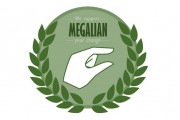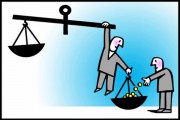Seolleongtang, a traditional soup made by simmering cow bones for hours until they produce a rich, flavorful broth, may be disappearing from Korean dinner tables, according to an October 21st report from YTN. Younger people are leaving the seolleongtang restaurants for hamburgers at Lotteria, a reflection of Korea’s new food culture. The changes are reflected in the sharp drop in prices for seolleongtang ingredients such as cow bones and ox tail, and the steep rise in prices for luxury cuts of beef like sirloin and tenderloin.
In contrast to the reporters’ opinion, online commentary questioned the idea that changing tastes in young people accounted for the new phenomenon, pointing the finger at high profile scandals in the restaurant industry and the influx of cheap American beef.
Article from YTN:
Young people turn away from gomtang, seolleongtang…prices for cow bones and tails plummet
They say tastes change as people grow older.
As young people stop eating gomtang and seolleongtang, the price for their ingredients, beef bones and byproducts, has plummeted.
But as demand for bones and cow byproducts drops, demand for sirloin and tenderloin cuts of beef continues to increase, leading to price jumps that impact the consumer. Jeon Joon Hyung has the report on this new market issue.
Here we are at a seolleongtang restaurant in Seoul at lunchtime. A good reputation brings plenty of customers, but most of the people enjoying the rich broth are elderly.
Younger diners crowd into fast food restaurants, where the food is convenient to eat and they can save time. Of course, these are the same people who grew up eating pizza and hamburgers since they were a child, so they are accustomed to the flavor.
Our reporter asks Kim Ye-ji, a high school sophomore, which she would prefer to eat, a hamburger or gomtang. She answers, “a hamburger.”
“Is there a particular reason?”
“Well, it tastes good, it’s cheap, and there are a lot of these places around my school, so I think that’s why I eat hamburgers a lot.”
Indeed, as young people stop ordering gomtang and seolleontang in restaurants, families are also preferring to make quick meals, further driving down the price of cow bones and byproducts.
Prices for cow bones, [necessary for creating the rich broth that is characteristic of gomtang and seollontang], have dropped 80% compared with 2005 levels. Prices for ox tails and cow legs have fallen by 60-70% during the same time period.
The problem is that as the cost of beef byproducts falls, the cost of sirloin and tenderloin meat keeps rising.
While prices for cow bones have been dropping in recent years, in the same period the prices of tenderloin and sirloin have increased by 150-200%
The phenomenon is similar to pork consumption habits within Korea, where the cost of every part except for the prized samgyeopsal [pork belly], has dropped.
Hwang Myeong-cheol, President of the Animal Husbandry Research Department at the Nonghyup Economic Research Institute, said, “If you think about all the different parts of one cow, when the price for a particular part drops, ranchers have to make up that loss by increasing the cost for the popular parts. This means that the cost for tenderloin and sirloin will increase as the popularity of the other parts decreases.”
In the future, it will be necessary to think about ways to increase consumption of all the different parts of a cow in order to maintain a competitive price for domestic beef as well as to promote gomtang and seolleongtang, Korea’s traditional foods, to the rest of the world.
Comments from Daum:
블루라떼:
It’s not just the young people who don’t eat gomtang or seolleongtang as much anymore… Older people also don’t think about gomtang or seolleontang like they used to, they’re no longer delicacies. First of all, there was the mad cow disease scare…and of course people’s whole impression of beef byproducts as ingredients has gotten worse…Then the biggest reason is all the stories in the news about the low quality ingredients that seolleongtang franchise restaurants put in their food. That has made people’s trust in the quality of the food drop a lot. Essentially, older people just don’t eat these dishes like they used to
도도한:
When it comes to Korean dishes that you have to boil for a long time, [like gomtang and seolleongtang], restaurants will never use quality ingredients. The only way to get quality is to cook it at home. A little while ago they were talking about a seolleongtang restaurant that was using scraps to make their food on the cheap, so that something that cost them ₩1000 to make would be sold for ₩8000, it’s because of stories like that that people don’t eat it anymore
쩡아:
The reason I don’t eat it is because it’s expensive…but I love the taste…can’t they just lower the price???
Jitteriness:
I loved the taste of seolleongtang and gomtang and used to eat it almost every day.. then I stopped completely once they started using imported American beef. 99% of the seolleongtang restaurants that say they use Australian beef are using American beef. The national traitor Lee Myung Bak also changed the tastes of his country
야옹이:
It’s been a few years since I had gomtang or seolleongtang. Who eats that anymore? Now they all make it with American beef… I wouldn’t eat it even if they were giving it away. I also tell my kids not to eat it…
삭풍:
The owners of gomtang and seolleongtang restaurants must be happy. Their prices have doubled over ten years ago while their major ingredient prices have been cut in half.
꾸꾸리:
There are no nutrients in bones. Anybody who knows about nutrition stays away from it, what’s the point of eating those foods?
SinceThen:
If it was cheap and made with real ingredients then who wouldn’t eat it? This article misses the point when it focuses on changing tastes
cjsdhahrvy:
Up until this spring I made gomtang often for my high school age child. I thought it was just warm and full of calcium.. And it was easy to heat it up and mix in a little rice for my child’s breakfast.. But once I heard that it was mostly fat I immediately stopped making it.
낙랑:
I’m in my fifties and I feel the same way about gomtang and seolleongtang… There are so many restaurants that tell people they’re eating Korean beef but then use whatever they want in the kitchen, so now even when I want to eat I stay away. Who can you trust anymore!
연장적예측-귀납적보외적:
The reason for the drop in price is because people have started using American beef with its risk for mad cow disease. It’s not because young people have stopped eating it. The businessmen who buy disease-ridden American beef import it cheaply and then sell it cheaply on the market here.
유아독존:
I was watching a program where a doctor came out and said seolleongtang was just a ball of fat. Ever since I heard it wasn’t good for you I just stopped eating it.
선녀와_그랬꾼:
And a bowl of seolleongtang is still ₩7000-8000, now do you understand why young people aren’t eating it?
아멘타불인샬라:
And yet once the price for a bowl of gomtang or seolleongtang goes up it never seems to come down
성투경매:
Get rid of destructive globalization – talk about trying to globalize Korean food is a bullshit pipe dream shut up about globalization
잡지봉지:
If the price of ingredients went down, wouldn’t the price of seolleongtang in restaurants also drop? They are very quick to raise their prices every time ingredient costs rise, but they always feign ignorant when ingredient prices drop. bastards
삼용:
globalized Korean food? ke ke ke then stop serving old banchan with your orders, [restaurants have been criticized for taking the uneaten portions of side dishes and serving them again to new diners]. Make a law that limits banchan portions and then charges for additional amounts, that’s the only way to fix it. Without a solution, globalizing Korean food will never work
rjan:
How could the tastes of the two generations be similar? Older people remember when it was hard to find anything to eat in the spring once the last year’s harvest had run out… young people are spoiled for choice and pick what to eat based on their health and trends… The basis of how people choose their food has changed.










